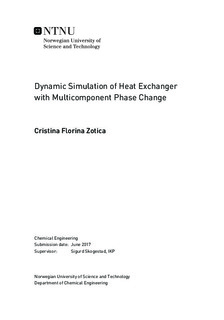Dynamic Simulation of Heat Exchanger with Multicomponent Phase Change
Master thesis
Permanent lenke
http://hdl.handle.net/11250/2459763Utgivelsesdato
2017Metadata
Vis full innførselSamlinger
Sammendrag
A dynamic model for a heat exchanger with multicomponent phase change, part ofreliquefaction cycle of natural gas, is developed. The finite control volume method isused to spatially discretize the heat exchange intro a series of lumps with constant volume.Vapor-liquid equilibrium is assumed in the vapor-liquid region of the phase envelope.The model is written in terms of differential and algebraic equations applied toeach lump (or cell).Different algebraic equations are valid in each of the phase regions (e.g. vapor, liquid,vapor-liquid), namely the vapor-liquid equilibrium condition is not satisfied in eitherof the single phases. Therefore, each phase region has its own set of differential andalgebraic equations. The number required to describe the two-phase region is highercompared to the single regions. Hence, dummy variables and equations (without aphysical meaning) are used in the single regions to in order to have the same numberof equations in all phases such that the same model can be used for simulating allphase regions. A logical conditions is implemented to select the corresponding set ofequations.The model is written and implemented in Matlab® for simulation purposes. Thephase change detection is automatically handled by an event function inside the solver.A few additional examples are used to investigate how the ode15s solver treats nonsmoothsystems, or how the algebraic equations are solved.The possibility of formulating the model as a mathematical problem with complementarityconstraints is also investigated.
